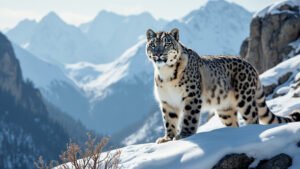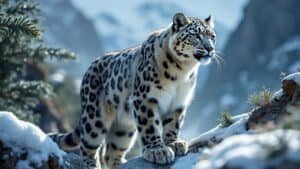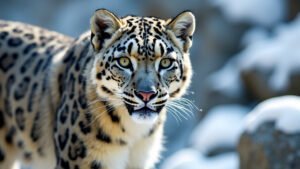Introduction
Conservationists are increasingly relying on genetic information to safeguard snow leopard populations, a species listed as vulnerable due to habitat loss, poaching, and climate change
This article will explore the various ways in which genetic research contributes to snow leopard conservation, from tracking populations and preventing inbreeding to identifying subspecies and combating illegal trade
We will delve into the technologies and techniques used in genetic studies, as well as review case studies that highlight the success of these efforts. By understanding the crucial role genetics plays, we can appreciate the strides being made in protecting these elusive big cats
Understanding the Role of Genetic Information in Snow Leopard Conservation
Genetic information has become a cornerstone in the efforts to conserve snow leopard populations, providing conservationists with critical data to make informed decisions
Snow leopards, known for their elusive nature and fragmented habitats, are challenging to monitor through traditional methods. However, genetic research offers a window into their lives that is otherwise inaccessible. By examining genetic markers, scientists can gain insights into population size, structure, and health, which are essential for developing effective conservation strategies
This section will explore the specific genetic markers used to track snow leopard populations, the significance of genetic diversity for their survival, and how genetic analysis helps prevent inbreeding, which is a significant threat to small, isolated populations
What Genetic Markers Are Used to Track Snow Leopards?
One of the most valuable tools in snow leopard conservation is the use of genetic markers to track and monitor populations. Genetic markers are specific sequences of DNA that vary among individuals and populations, making them ideal for identifying individual animals and assessing population structure
Microsatellites, also known as short tandem repeats (STRs), are commonly used genetic markers in wildlife studies, including snow leopards. These markers are highly polymorphic, meaning they exhibit a high degree of variation, which is useful for distinguishing between individuals and understanding genetic diversity within a population
A study by Janečka et al. (2017) highlighted the use of noninvasive genetic techniques, such as analyzing DNA from feces, hair, or urine, to monitor snow leopard populations across their vast range. By examining microsatellites, researchers were able to estimate population sizes, detect genetic bottlenecks, and assess gene flow between populations, which is crucial for maintaining genetic diversity and reducing the risk of inbreeding .
Analyzing Genetic Diversity and Its Impact on Snow Leopard Survival
Genetic diversity is a critical factor in the survival and adaptability of any species, including snow leopards. High genetic diversity within a population increases its resilience to environmental changes, diseases, and other threats
Conversely, low genetic diversity can lead to inbreeding depression, where the accumulation of deleterious genes results in reduced fitness, lower reproductive success, and increased susceptibility to diseases
Research conducted by Sharma et al. (2019) on snow leopard populations in the Indian Himalayas revealed significant genetic diversity within these populations, which is a positive indicator of their potential for long-term survival. The study emphasized the importance of maintaining this diversity by ensuring that populations remain connected through corridors that facilitate gene flow
This connectivity helps prevent isolated populations from becoming genetically impoverished, which can happen when gene flow is restricted due to habitat fragmentation or other barriers
Genetic data also allows conservationists to identify and prioritize genetically unique populations that may be at greater risk. By focusing conservation efforts on these populations, they can help preserve the overall genetic diversity of the species, which is essential for its continued survival in the wild
Preventing Inbreeding Through Genetic Analysis
Inbreeding poses a significant threat to snow leopard populations, especially those that are small and isolated
When closely related individuals breed, there is a higher likelihood of offspring inheriting harmful genetic mutations, leading to inbreeding depression. This can manifest in various ways, including reduced fertility, higher mortality rates, and an increased prevalence of genetic disorders
Genetic analysis plays a crucial role in preventing inbreeding by allowing conservationists to monitor the genetic health of populations and make informed decisions about management practices
For example, in managed breeding programs, such as those in zoos or captive breeding facilities, genetic data is used to pair individuals that are genetically diverse, thereby minimizing the risk of inbreeding. In the wild, this information can inform translocation efforts, where individuals from different populations are moved to increase genetic diversity and reduce the risk of inbreeding
A notable example of this approach is the work done by the Snow Leopard Trust and its partners, who have used genetic data to guide conservation strategies in various regions. By understanding the genetic relationships between different populations, they have been able to implement measures that promote gene flow and reduce the likelihood of inbreeding
Technologies and Techniques for Snow Leopard Genetic Research
Advancements in genetic research have provided conservationists with powerful tools to study and protect snow leopards. As these elusive cats inhabit some of the most remote and rugged terrains on Earth, traditional monitoring methods often fall short
Genetic technologies, however, offer a noninvasive and highly accurate means of gathering vital data. This section explores the cutting-edge technologies used in snow leopard genetic research, the noninvasive methods for collecting genetic samples, and the challenges faced in analyzing these genetic data
Advances in DNA Sequencing for Snow Leopards
DNA sequencing has revolutionized wildlife conservation, enabling scientists to decode the genetic blueprint of species like the snow leopard. One of the most significant advances in this field is the development of next-generation sequencing (NGS) technologies
NGS allows for the rapid and comprehensive analysis of entire genomes, providing insights into the genetic diversity, population structure, and evolutionary history of snow leopards
Researchers use NGS to identify genetic variations that are specific to snow leopard populations, which can help in understanding how these cats adapt to their harsh environments. For example, specific genes related to high-altitude adaptation, such as those involved in oxygen transport and metabolism, can be studied in detail
This information is crucial not only for understanding the biology of snow leopards but also for identifying populations that may be particularly vulnerable to environmental changes or diseases
Moreover, DNA sequencing is essential for the identification of individual animals, which helps in estimating population sizes and monitoring changes over time
By comparing genetic sequences from different individuals, conservationists can track genetic drift, gene flow, and other factors that influence the health and viability of snow leopard populations
Noninvasive Methods for Collecting Genetic Samples
Collecting genetic samples from snow leopards poses unique challenges due to their secretive nature and the difficult terrain they inhabit
Traditional methods, such as capturing and collaring animals, are not only risky and stressful for the animals but also logistically challenging. To overcome these challenges, conservationists have developed noninvasive methods for obtaining DNA samples from snow leopards
One of the most widely used techniques is the collection of environmental DNA (eDNA) from feces, hair, and urine left behind by snow leopards. These samples contain cells shed by the animals, from which DNA can be extracted and analyzed. Fecal DNA sampling, in particular, has proven to be an effective method for studying snow leopard populations without disturbing them
This method allows researchers to gather information on the genetic diversity, diet, and health of snow leopards, as well as their territorial and social behaviors
Another noninvasive technique involves the use of hair snares, which are devices that collect hair samples as snow leopards pass by. These snares are placed in strategic locations, such as along trails or near scent-marking sites
The hair samples collected can then be analyzed for DNA, providing insights into the identity and genetic makeup of the individuals using those areas
These noninvasive sampling methods have been instrumental in expanding our understanding of snow leopard populations, particularly in regions where direct observation is nearly impossible. They also minimize human-wildlife conflicts, as they do not require capturing or handling the animals
Challenges in Analyzing Snow Leopard Genetic Data
Despite the advancements in genetic technologies, analyzing snow leopard genetic data presents several challenges. One of the primary issues is the quality and quantity of DNA obtained from noninvasive samples
DNA from feces, hair, and other environmental sources is often degraded or present in very low quantities, making it difficult to obtain reliable genetic information
To address these challenges, researchers have developed various techniques to improve the quality of DNA extraction and amplification. Polymerase chain reaction (PCR) is commonly used to amplify small amounts of DNA, allowing for more detailed analysis. However, even with these advancements, the risk of contamination and the possibility of obtaining mixed DNA from multiple individuals in a single sample remain concerns
Another challenge is the interpretation of genetic data in the context of snow leopard conservation. Genetic studies often reveal complex patterns of population structure and gene flow, which can be difficult to translate into practical conservation actions
For example, understanding the genetic connectivity between populations requires not only detailed genetic data but also ecological and geographical information. This complexity can make it challenging to develop clear conservation strategies based solely on genetic data
Additionally, the rugged and remote habitats of snow leopards make it difficult to conduct comprehensive genetic studies. Accessing these areas often requires significant resources, and the logistical difficulties can limit the scope and scale of genetic research. Furthermore, political and social factors in the regions where snow leopards live can also impact the ability to collect and share genetic data
Despite these challenges, ongoing advancements in genetic technologies and methodologies continue to improve the accuracy and applicability of genetic research in snow leopard conservation. As these tools become more refined and accessible, they will play an increasingly important role in ensuring the survival of this iconic species
Applying Genetic Data in Snow Leopard Conservation Strategies
Genetic data is not only a tool for understanding snow leopard populations but also a critical resource for developing and implementing conservation strategies. By leveraging the information gleaned from genetic research, conservationists can make informed decisions that directly impact the survival of snow leopards
This section will discuss how genetic data is used to identify and protect snow leopard subspecies, combat poaching, and facilitate global collaboration among conservation efforts
Using Genetics to Identify and Protect Snow Leopard Subspecies
One of the most important applications of genetic data in snow leopard conservation is the identification of subspecies or distinct population segments
Snow leopards inhabit a vast and varied range across Central and South Asia, and genetic studies have revealed significant differences between populations in different regions. These genetic differences can indicate the presence of subspecies or evolutionarily significant units (ESUs), which are critical for preserving the genetic diversity of the species
For instance, a study published by McCarthy et al. (2020) discussed how genetic analyses identified distinct snow leopard populations in the Himalayas, Pamirs, and Altai mountains
Recognizing these differences is crucial because each population may have unique adaptations to their specific environments, and losing one could mean the loss of valuable genetic traits. Conservation strategies can then be tailored to protect these distinct populations, ensuring that the genetic diversity necessary for the species’ long-term survival is maintained
By identifying and protecting these subspecies or distinct populations, conservationists can prioritize areas for conservation efforts, establish protected corridors to maintain gene flow, and prevent the homogenization of the species’ gene pool. This approach ensures that conservation actions are scientifically informed and target the most vulnerable or unique populations
Combatting Poaching with Genetic Information
Poaching is one of the most significant threats to snow leopards, driven by the illegal trade of their pelts, bones, and other body parts
Genetic data has become an essential tool in combatting poaching by providing forensic evidence that can be used to trace the origin of confiscated wildlife products and link them to specific populations
Forensic genetics involves the analysis of DNA from seized snow leopard parts to determine their geographical origin. This can help law enforcement agencies track poaching hotspots and identify poaching networks
A study by Zhang et al. (2021) demonstrated the effectiveness of using genetic markers to trace the origin of snow leopard pelts, which has been instrumental in prosecuting wildlife criminals and dismantling illegal trade operations. By linking poached animals to specific populations, conservationists can also assess the impact of poaching on those populations and take targeted actions to mitigate the damage
Moreover, genetic data can be used to monitor the genetic diversity of snow leopard populations over time, allowing conservationists to detect any decline in genetic health that may result from poaching. This information is critical for adjusting conservation strategies to address the immediate and long-term effects of poaching on snow leopard populations
Collaborative Efforts in Sharing Genetic Data Globally
Conservation of snow leopards is a global effort, requiring collaboration across countries and continents
The sharing of genetic data among conservation organizations, research institutions, and governments is vital for coordinating these efforts and ensuring that all stakeholders have access to the most up-to-date and comprehensive information
Global databases, such as the Snow Leopard Genome Project, have been established to facilitate the sharing of genetic data. These databases allow researchers to compare genetic data from snow leopards across different regions, identify patterns of genetic diversity and gene flow, and assess the overall health of global snow leopard populations
This collaborative approach helps to avoid duplication of efforts, ensures that conservation strategies are based on the best available science, and fosters international cooperation in snow leopard conservation
Additionally, sharing genetic data globally supports the development of standardized protocols for genetic research and conservation practices. This ensures that genetic studies conducted in different regions are compatible and that the data can be integrated into a broader understanding of snow leopard conservation needs
International workshops, conferences, and working groups focused on snow leopard genetics further enhance collaboration and the exchange of knowledge among experts
The benefits of global collaboration extend beyond genetic research to include coordinated efforts in law enforcement, habitat protection, and public awareness campaigns. By working together, countries within the snow leopard’s range can implement more effective conservation strategies that address the challenges facing the species on a regional and global scale
Case Studies: Successes in Snow Leopard Conservation Through Genetics
The application of genetic research in snow leopard conservation has led to several notable successes, demonstrating the effectiveness of these scientific approaches in real-world scenarios
These case studies highlight how genetic data has been used to achieve significant conservation milestones, from population recovery to the identification of critical genetic corridors. By examining these success stories, we can gain a better understanding of how genetics can be harnessed to protect endangered species like the snow leopard
Notable Conservation Success Stories
One of the most compelling examples of genetic research aiding snow leopard conservation is the work done in the Altai-Sayan region of Russia and Mongolia
This area, which is home to a significant portion of the global snow leopard population, has seen substantial conservation efforts driven by genetic data. Researchers conducted extensive genetic surveys to map the population structure and identify critical areas for conservation
The results of these studies led to the creation of new protected areas and wildlife corridors that connect fragmented habitats, allowing for gene flow between isolated snow leopard populations
These measures have been instrumental in stabilizing the local snow leopard population and ensuring its long-term viability. The success of these initiatives has been recognized internationally and serves as a model for other regions where snow leopard populations are under threat
Another success story comes from the Himalayan region, where genetic research has played a crucial role in the recovery of snow leopard populations. In this region, conservationists used genetic markers to track population changes over time and to assess the effectiveness of anti-poaching measures
The genetic data revealed that, despite significant poaching pressure in the past, the population was recovering due to enhanced protection efforts. This information was used to strengthen anti-poaching laws and improve enforcement, leading to further population growth
Impact of Genetic Research on Population Recovery
The impact of genetic research on snow leopard population recovery is evident in the way it has informed and guided conservation strategies. For example, in Kyrgyzstan, genetic data was used to establish a community-based conservation program that involved local herders in the protection of snow leopards
By educating these communities about the importance of genetic diversity and the role of snow leopards in the ecosystem, conservationists were able to reduce human-wildlife conflict and increase local support for conservation efforts
The program also included genetic monitoring of the local snow leopard population to track changes in genetic diversity and identify any emerging threats. This proactive approach allowed conservationists to intervene quickly when signs of inbreeding or genetic decline were detected, ensuring that the population remained healthy and viable
The success of this program has led to its expansion into other regions, further contributing to the recovery of snow leopard populations across Central Asia
Future Directions in Snow Leopard Genetic Conservation
As genetic technologies continue to advance, the potential for even greater successes in snow leopard conservation becomes clear. One promising area of research is the use of CRISPR and other gene-editing technologies to address specific genetic issues within snow leopard populations
While still in the experimental stages, these technologies could one day be used to enhance genetic diversity, correct harmful mutations, or even introduce beneficial traits that improve the species’ resilience to environmental changes
Another future direction is the integration of genetic data with ecological and behavioral studies to create more comprehensive conservation strategies
By combining genetic information with data on snow leopard movement patterns, prey availability, and habitat use, conservationists can develop more targeted and effective interventions. This holistic approach could lead to more successful outcomes in both protecting and restoring snow leopard populations
Moreover, continued international collaboration and the sharing of genetic data will be crucial for the future of snow leopard conservation. As more countries and organizations contribute to global genetic databases, the collective knowledge about snow leopard genetics will expand, leading to new insights and more effective conservation strategies
The ongoing commitment to using genetic research as a tool for conservation will be key to ensuring the long-term survival of snow leopards in the wild
Conclusion
Genetic information has become an indispensable tool in the conservation of snow leopards, offering insights that are crucial for the survival of this elusive species. Through the use of genetic markers, conservationists can track and monitor populations, analyze genetic diversity, and implement strategies to prevent inbreeding, all of which are vital for maintaining healthy and resilient snow leopard populations
Advances in genetic technologies, such as DNA sequencing and noninvasive sampling methods, have greatly enhanced our ability to study these animals in their remote habitats without causing them harm. Furthermore, the application of genetic data in identifying and protecting distinct subspecies, combatting poaching, and fostering global collaboration has led to significant conservation successes, as evidenced by the case studies highlighted
As we look to the future, continued innovation in genetic research, combined with international cooperation, will be key to overcoming the challenges that still threaten snow leopards and ensuring their long-term preservation in the wild













